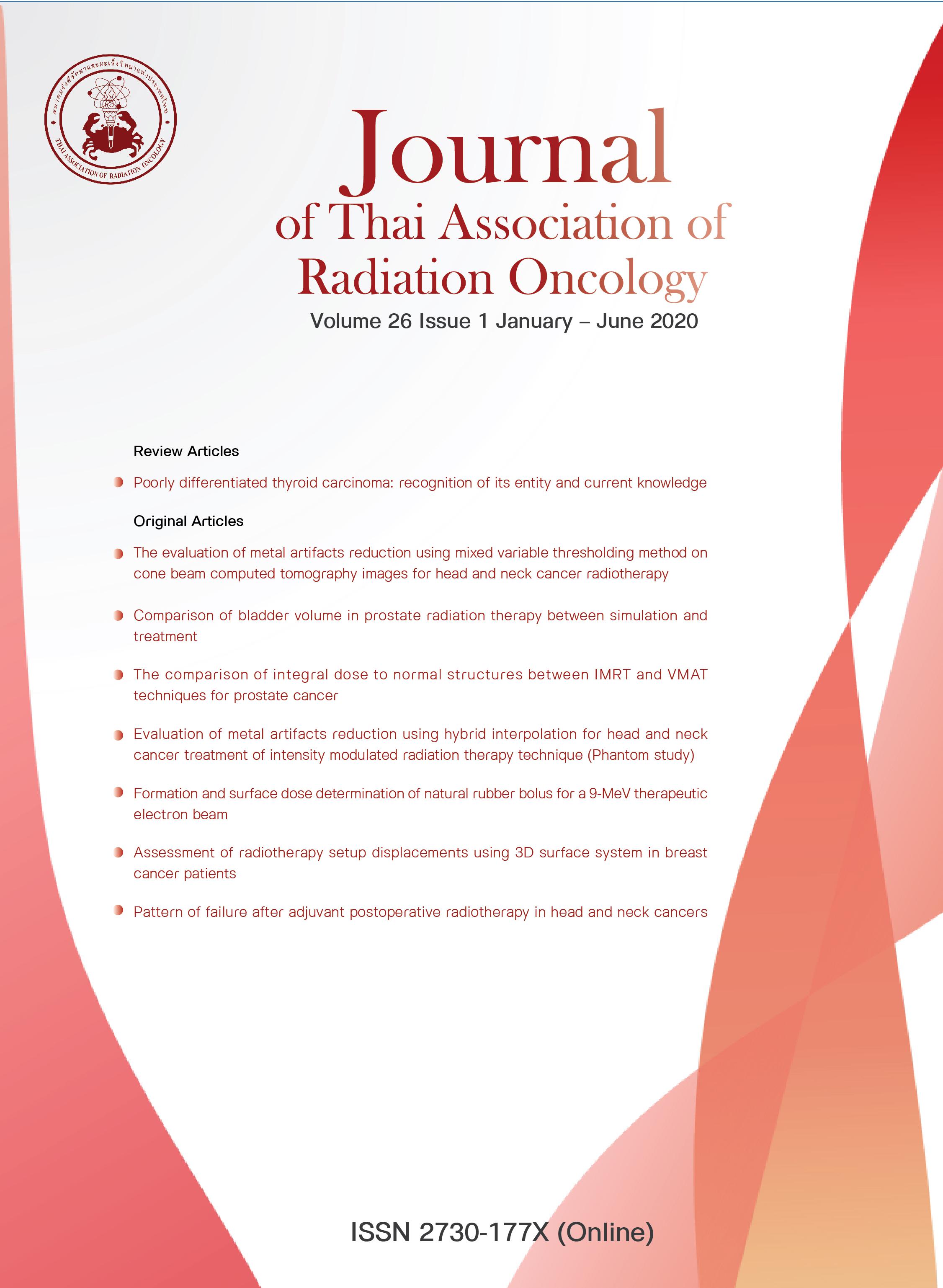The comparison of integral dose to normal structures between IMRT and VMAT techniques for prostate cancer
Keywords:
Prostate cancer, IMRT, VMAT, Integral doseAbstract
Background: The integral dose is the volume integral of the dose deposited in the treated volume. The energy and number of beams entry are directly effecting to the ID, especially the advance technique in radiotherapy.
Objective: To compare the integral dose (ID) of organ at risk (OAR) between IMRT and VMAT techniques by using 6MV and 15MV photon energy for prostate cancer.
Materials and Methods: Six prostate cancer patients were re-planned with IMRT and VMAT by using 6 MV and 15 MV. The plans were by using 6MV and 15MV photon energy. The prescription dose was 79.2 Gy in 44 fractions. The ID (mean dose ´ tissue volume) received by bladder, rectum, and normal tissue (NTID) was evaluated.
Results: The ID of bladder and rectum was not significantly different for both IMRT and VMAT techniques. However, VMAT showed higher NTID than IMRT with significant due to more incident beams than IMRT. For different energy, 15 MV showed lesser NTID than 6 MV with significantly. The monitor units (MU) to deliver for a single fraction was significantly reduced in VMAT technique.
Conclusion: The advantage of VMAT over IMRT was reducing the NTID. For 15 MV, the treatment time also reduced, which represent by MUs calculation.
References
มะเร็งต่อมลูกหมาก [cited Sep 14, 2019]. Available from: https://medthai.com.
การฉายรังสีสําหรับผู้ป่วยมะเร็ง [cited Sep 14, 2019]. Available from: https://www.chulacancer.net/patient-knowledge-inner.php?gid=128.
มะเร็งต่อมลูกหมากโรคร้ายของสุขภาพชาย [cited Oct 27, 2019]. Available from: https://med.mahidol.ac.th/cancer_center/sites/default/files/public/pdf/Booklet/Booklet-Prostate-Cancer.pdf.
Bumrungrad International Hospital [cited Sep 14, 2019]. Available from: https://www.bumrungrad.com/th/conditions/prostate-cancer.
หลักการรักษาด้วยรังสี [cited Sep 14, 2019]. Available from: https://www.chulacancer.net/patient-list-page.php?id=420.
Kry SF, Bednarz B, Howell RM, Dauer L, Followill D, Klein E, et al. AAPM TG 158: measurement and calculation of doses outside the treated volume from external‐beam radiation therapy. Med Phys. 2017;44:e391-e429.
การรักษามะเร็งต่อมลูกหมากด้วยวิธีรังสีรักษา [cited Sep 14, 2019]. Available from: https://www.bumrungrad.com/th/health-blog/April-2017/prostate-cancer-radiothery-treatment.
ชวลิต เลิศบุษยานุกูล. การฉายรังสีแบบปรับความเข้มในมะเร็งบริเวณศีรษะและลำคอ (IMRT of Head and Neck Cancer) [cited Oct 12, 2019]. Available from: https://chulacancer.net/education-inner.php?id=392.
Prostate cancer metastasis: Where does prostate cancer spread? [cited Dec 5, 2019]. Available from: https://mayocl.in/34R8sIh.
Tyagia A, Supe SS, Sandeep, Singh MP. A dosimetric analysis of 6MV versus 15MV photon energy plans for intensity modulated radiation therapy (IMRT) of carcinoma of cervix. Rep Pract Oncol Radiother. 2010;15: 125–31.
Aoyama H, Westerly DC, Mackie TR, Olivera GH, Bentzen SM, Patel RR, et al. Integral radiation dose to normal structures with conformal external beam radiation. Int J Radiat Oncol Biol Phys. 2006;64:962-7.
Nguyen F, Rubino C, Guerin S, Diallo I, Samand A, Hawkins M, et al. Risk of a second malignant neoplasm after cancer in childhood treated with radiotherapy: correlation with the integral dose restricted to the irradiated fields. Int J Radiat Oncol Biol Phys. 2008;70:908-15.
Slosareka K, Osewskib W, Grzadziela A, Radwana M, Dollaa L, Szlaga M, et al. Integral dose: Comparison between four techniques for prostate radiotherapy. Rep Pract Oncol Radiother. 2015;20:99–103.
Ost P, Speleers B, De Meerleer G, De Neve W, Fonteyne V, Villeirs G, et al. Volumetric arc therapy and intensity-modulated radiotherapy for primary prostate radiotherapy with simultaneous integrated boost to intraprostatic lesion with 6 and 18 MV: a planning comparison study. Int J Radiat Oncol Biol Phys. 2011;79:920-6.
Kumar L, Yadav G, Raman K, Bhushan M, Pal M. The dosimetric impact of different photon beam energy on RapidArc radiotherapy planning for cervix carcinoma. J Med Phys. 2015;40:207.
Thangavelu S, Jayakumar S, Govindarajan K, Supe SS, Nagarajan V, Nagarajan M. Influence of photon energy on the quality of prostate intensity modulated radiation therapy plans based on analysis of physical indices. J Med Phys. 2011;36:29.
Chung J-B, Kim J-S, Kim I-A, Lee J-W, Cho W, Suh T-S. The effect of photon energy on the intensity-modulated radiation therapy plan for prostate cancer: a planning study. J Korean Phys Soc. 2011;59:183-8.
Kry SF, Salehpour M, Followill DS, Stovall M, Kuban DA, White RA, et al. Out-of-field photon and neutron dose equivalents from step-and-shoot intensity-modulated radiation therapy. Int J Radiat Oncol Biol Phys. 2005;62:1204-16.
Ruben JD, Davis S, Evans C, Jones P, Gagliardi F, Haynes M, et al. The effect of intensity-modulated radiotherapy on radiation-induced second malignancies. Int J Radiat Oncol Biol Phys. 2008;70:1530-6.
Kry SF, Salehpour M, Titt U, White RA, Stovall M, Followill D. Monte Carlo study shows no significant difference in second cancer risk between 6-and 18-MV intensity-modulated radiation therapy. Radiother Oncol. 2009;91:132-7.
Kim S, Alaei P. Implementation of full/half bowtie filter models in a commercial treatment planning system for kilovoltage cone‐beam CT dose estimations. J Appl Clin Med Phys. 2016;17:153-64.
Downloads
Published
How to Cite
Issue
Section
License
บทความที่ได้รับการตีพิมพ์เป็นลิขสิทธิ์ของวารสารมะเร็งวิวัฒน์ ข้อความที่ปรากฏในบทความแต่ละเรื่องในวารสารวิชาการเล่มนี้เป็นความคิดเห็นส่วนตัวของผู้เขียนแต่ละท่านไม่เกี่ยวข้องกับ และบุคคลากรท่านอื่น ๆ ใน สมาคมฯ แต่อย่างใด ความรับผิดชอบองค์ประกอบทั้งหมดของบทความแต่ละเรื่องเป็นของผู้เขียนแต่ละท่าน หากมีความผิดพลาดใดๆ ผู้เขียนแต่ละท่านจะรับผิดชอบบทความของตนเองแต่ผู้เดียว




